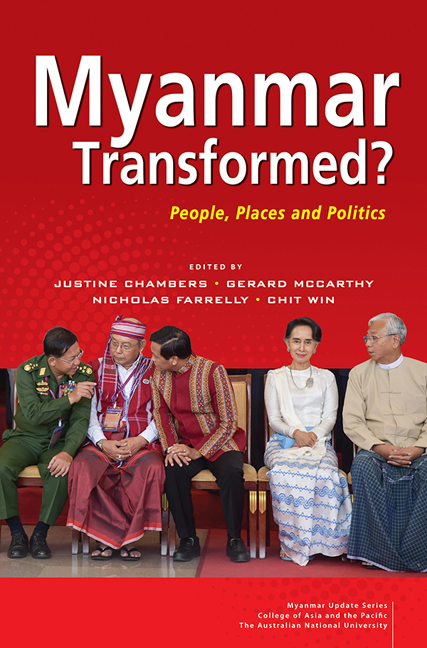Book contents
- Frontmatter
- Contents
- List of Tables
- List of Figuress
- Acknowledgements
- Contributors and Editors
- Part I Introduction
- Part II People
- 2 Documenting Social and Economic Transformation in Myanmar's Rural Communities
- 3 Social Protection in Myanmar: A Key Mechanism for Political Legitimacy?
- 4 Health Service Delivery and Peacebuilding in Southeast Myanmar
- Part III Places
- Part IV Politics
- Part V Epilogue
- Abbreviations and Key Terms
- Index
4 - Health Service Delivery and Peacebuilding in Southeast Myanmar
from Part II - People
Published online by Cambridge University Press: 12 February 2019
- Frontmatter
- Contents
- List of Tables
- List of Figuress
- Acknowledgements
- Contributors and Editors
- Part I Introduction
- Part II People
- 2 Documenting Social and Economic Transformation in Myanmar's Rural Communities
- 3 Social Protection in Myanmar: A Key Mechanism for Political Legitimacy?
- 4 Health Service Delivery and Peacebuilding in Southeast Myanmar
- Part III Places
- Part IV Politics
- Part V Epilogue
- Abbreviations and Key Terms
- Index
Summary
Myanmar has been experiencing internal armed conflict between successive Bamar-led governments and Ethnic Armed Organizations (EAO) for nearly seven decades. By the time of independence from the British Empire in 1948, ethnicity had become a defining category of political orientation in Burma and years of ethnic tensions led to violence across the country (Smith 1991). Since the outbreak of armed conflict between the Karen National Union (KNU) and the newly independent government of Burma in January 1949 on the outskirts of Yangon and across the country, the country has seen more than six decades of civil conflict.
Years of counterinsurgency strategies by the Myanmar Army (Tatmadaw), especially through its “four cuts” strategy—Pya Lay Pya— had severe negative consequences on local populations living in conflictaffected areas of Myanmar's ethnic states. Adopted in 1968, the doctrine was to sever insurgents from their key inputs: funding, food, intelligence and recruits (ICG 2000, p. 17). Communities suffered both from brutal repression and severe human rights abuses by the Tatmadaw, and also from systematic structural discrimination and political repression. The military's approach to civilians and ethnic minority people in particular was reflected in minimal spending on social services and development in general during the authoritarian period (see Mangshang & Griffiths, Chapter 3 this volume).
In response to the dire needs of conflict-affected communities, EAOs and their aligned civil society networks established their own structures for community-based primary health care service provision. A coalition of four EAO health departments and three local non-governmental health organizations in southeast Myanmar collectively known as Ethnic Health Organizations (EHOs) emerged parallel to the government health system run by the Myanmar Ministry of Health and Sports (MoHS). A range of basic health services such as for the treatment of common diseases, warinjury management, reproductive and child health care services, community health education, and water and sanitation programmes have developed over time. Due to the shifting zones of armed conflict and governance, rural parts of southeast Myanmar in particular play host to a mosaic of stationary clinics and mobile teams operated by these EHOs, supported by funding from international aid donors (Davis and Jolliffe 2016, p. 10).
- Type
- Chapter
- Information
- Myanmar Transformed?People, Places and Politics, pp. 85 - 106Publisher: ISEAS–Yusof Ishak InstitutePrint publication year: 2018

